The Mission Phase II:
Training Tips
Training Tips

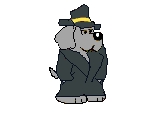
|
OK…Now we are getting down to the core of the mission. Keep in mind that the subject of your mission, the Weimaraner puppy, can be very intelligent. As such he can be a great manipulator. Therefore you must constantly work to be more intelligent than he is. The basic outline we have for you here is general guidelines…what we have found worked to help us complete our mission. Just keep in mind This outline is not intended to discourage anyone from signing up for obedience classes. In fact we greatly encourage anyone who brings home a Weimaraner puppy to complete formalized obedience classes with the puppy. These are just some basic supplemental ideas you can work on before you get the puppy in class, or ideas you can use to tailor your training course to fit the needs of your Weimaraner puppy.
Some tips before you start: |

|
*Training Attitude:
Remember that training should be a fun time for you and the puppy. If you are feeling stressed or grumpy, don't train until you are feeling better. Train with the puppy's tail wagging. |

|
* Training Tools:
There are a variety of opinions about reinforcers. Some trainers say no food reinforcers, others say to use them. Others say use conditioned reinforcers such as clickers, and others say use praise. And a very small minority may say to use physical punishment. We do not believe in using physical punishment. This breed is the type that can keep grudges, and physical punishment may actually make it harder to train a Weimaraner. In addition you can create a "hand shy" Weimaraner. In cases when you are trying to get the Weimaraner to STOP a negative behavior, we recommend using a loud stern "NO" or a shake can. We do not recommend punishment to get a Weimaraner to START performing an action. (more on this in the section "Dealing with Problem Behaviors"). OK...back to reinforcers. We believe that you should use whatever reinforcer works best with your individual puppy. You may need to experiment to find what your puppies "buttons" are. After saying that though, we believe that food reinforcers should be a last resort, to be used only if you find the puppy is not responding to voice or conditioned reinforcers. |
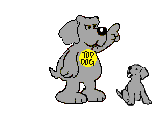
|
*The Trainer:
Keep in mind that YOU are the trainer, not the puppy. The Weimaraner puppy will often try and take this coveted position from you. Don't let him. You must establish dominance. Dogs are a pack animal, and when they become part of your family, you become part of their pack. In packs, there is a definite hierarchy, from the most dominant member to the most submissive member. The Weimaraner puppy must know who the boss is! By being firm and consistent, you can let him know who is top dog. |

|
*Time Limits:
Keep your training sessions short…5-10 minutes at first. You can increase the time as the puppy matures. Several short sessions a day is much better than one long session. Try to stop before the puppy gets bored or frustrated. Remember...you want training time to be fun. Try to end every session on an upbeat note…with an easy exercise, and a lot of praise. *Time Frame: Even though Weimaraners can be trained at most any age, the optimal time to begin trainning a Weimaraner is between 2 and 4 months of age. This early training helps Weimaraners understand what is to be expected, before bad habits are learned. |
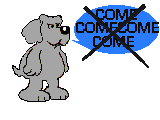
|
*Commands:
Remember to give commands only once before enforcing the command. Otherwise a Weimaraner will learn that he can get away with not obeying until the seventh or eighth or ninth… command. Many people also give hand signals with their commands. This way the dog will know a voice command as well as a hand signal. Have a release command such as "that's all" for when you are ready for the dog to stop performing the particular command you are working on. |
Ok, keeping all this in mind…lets start with Weimaraner Preschool:
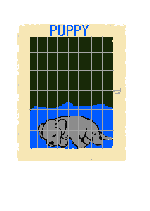
|
I. Preschool:
A. Crate Training Crate training is best accomplished with a puppy. Older dogs are much harder to crate train. Let younger children know that the crate is not a playhouse for them, but a special place for the puppy. You can put the puppy's bed inside the crate, and add treats and toys to entice the puppy inside. Most puppies will readily accept the crate, yet there are a few who will resist it. The resistant puppy may howl, bark, whine and/or scratch to be let out. This is likely due to the fact that the puppy does not like accepting controls, rather than because of the crate. Don't reward the behavior by letting him out…until he is quiet for at least 5 minutes. If you can't stand the noise, leave the house for a little while. Don't weaken your resolve…remember you are helping the puppy in the long run. |

|
B. Housetraining
Some diligent attention to your puppy can really pay off in the long run in terms of housetraining. Puppies almost always need to eliminate after eating and after waking up from a nap. When the puppy starts to tire, coax him into his crate for a nap. After he wakes up, he will whine to be let out of the crate because he will not want to eliminate in his sleeping area. Take him out and lavish him with praise when he eliminates outside (try to wait till he is done though, or he may stop midstream to try and be part of the excitement.) After you bring him back inside you can enjoy some playtime together. If you must do chores, confine him to the room you are in so you can keep a close eye on him. Try to take him out every 30-60 minutes while he is awake. Also take him out immediately after he finishes a meal. When you do notice the puppy eliminating inside, make a loud noise (yell no, clap, use shake can, or use a rolled paper on the counter…) to scare him. Then immediately take him outside to finish eliminating…and again praise him when he is done. It is NOT advisable to use physical punishment with this breed, or to rub his nose in "it". If you find a puddle and did not see him make it…shame on you for not paying attention. Just clean it up. Don't punish him belatedly. He has likely forgotten about it! This method takes a lot of work on your part while the puppy is awake, but in the long run we think it is quicker and more painless than most other methods! |

|
II. Kindergarten
|
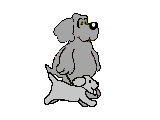
|
A. Lead Training
Lead training can begin shortly after the puppy is brought home. Attach a lead or a rope with a knot on the end to the puppy's collar (not a choke collar) and let him drag it around. Make sure you supervise him, as it will get caught on things. After he gets use to dragging the lead around you can proceed to pick the lead up and coax him to follow you. If he is resistant…go back to letting him drag the lead around some more. Once he starts following you willingly, condition him to stay on your left. Use a command such as heel, to let him know it is time to stand on your left, and follow you wherever you go. If the lead does become taunt, give a quick, firm tug and release, and say "puppy heel". Never get in a pulling match with the puppy. Use an upbeat voice and praise him when he is doing well. Remember to keep lead training fun. This will make a big difference in the Weimaraner's attitude while on the lead. You eventually want the Weimaraner to be able to walk on the lead with his head and tail held high, a sign of confidence. |

|
III. The Stand (mainly for people why may want to show their puppy in the future)
Hold the puppy's head with your right hand around his muzzle to keep him still. Place the feet with your left hand. When placing the feet, run your hand down his leg, (or along his back then down his leg for the rear legs) to the joint. Do not just grab a leg and pick it up to move it. While holding the joint, place the foot gently in it's place. The toes should all face forward. Look at pictures of dogs that are "stacked" to get an idea where to place the feet. Remember to give the "stand" command while doing this, and give the puppy lots of praise in a calm voice. After the feet are in place, gently stroke the underside of the puppy's tail in order to get him to hold it up. Have someone else look at the puppy's teeth, and run their hands over his chest, back and rear. Slowly lengthen the amount of time he is to hold this pose. When he is proficient at doing this, work on stacking him while holding his collar rather than his muzzle. |
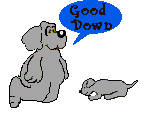
|
IV. The Down
This is lesson is accomplished when the Weimaraner is sitting. Say "down" once. Then say it again as you take the puppy's front paws and ease him down. Once he is down praise him, but again not too enthusiastically or he may jump right back up. With repeated practice, over time, the Weimaraner will eventually get the idea, and be able to lie down without help. |
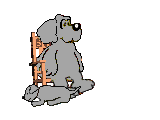
|
IV The Extended Down-Stay
This exercise has been shown to be especially useful for hyperactive dogs, and dogs that constantly challenge you for "top dog" status. Teach this command with the lead on. Simply give the command for down…have the puppy lay down, say "stay" then put the lead under the leg of a chair you are sitting on. Make the lead short enough so that the puppy cannot stand up comfortably. Therefore he has the choice to lay down and be comfortable, or try to stand and be uncomfortable. When he is lying down pet him gently. Stop if he is trying to stand. After the puppy lies quietly for a while, give the release command, let him loose and praise him. After he understands this command, he should be able to lay down and stay without the lead on, until released by you. |

|
IV. The Recall
This exercise is difficult to teach, especially with a Weimaraner. This breed is often wise to when the command can and cannot be reinforced. Therefore, until the puppy is proficient at coming when called, never use the command while the puppy is off lead. When the puppy does come on the first command, praise him profusely! If he does not come, give a tug and release on the lead and say come. Repeat this until he does come. (Remember not to get into a tug of war!) Praise him when he comes. Repeat this exercise on lead several times a day, and in several locations. If the puppy does get out free somewhere before he learns this command don't be tempted to call him, and do not chase him. Often running the other way will bring the puppy running. If this does not work, opening the door of the house or the car will likely work. After he seems to be trained to come…you may experience (hopefully not) a Weimaraner who will look you in the eye after you command him to come, and run the other way. Again don't chase him, and never punish him after he eventually comes. Otherwise he may associate "come" with punishment. Remember to never call a Weimaraner if you are going to do something to him he won't like (for example, give him a medicine he hates. Go and get him instead. The recall should always be associated with positive reinforcement for the Weimaraner. |

|
V. The Sit
Notice we have put this command after several of the others. This is because this is a fairly easy command to teach a puppy. If you plan on showing your puppy we do not recommend teaching this command until the Weimaraner is proficient at the other commands. Other wise the Weimaraner will sit whenever he feels unsure or frustrated in order to receive praise. This can be frustrating when teaching a puppy the stand. To teach this command say "sit". Hold the lead in you right hand and put your left arm behind the stifles, the bend in the rear legs. Push in slightly until he puppy is sitting. Then praise him (again not too enthusiastically!) Some people teach the sit by pushing down on the puppy's hindquarters. We do not recommend this, especially for show dogs. If you use this method, then when the judge examines the dog's hindquarters, the dog is more likely to sit! |
What we have outlined here are just some basic techniques and ideas that we have learned throughout the years. Again, we encourage you to enroll your puppy in formalized puppy kindergarten and obedience classes. Also keep in mind that training a puppy or dog takes time and work, so don't get discouraged, make it fun and be consistent!
| Phase I: Preparing for the Puppy |
| Phase III: Grooming |
| Phase IV: Troubleshooting |
| Phase V: Coming Soon...Frequently Asked Questions |
